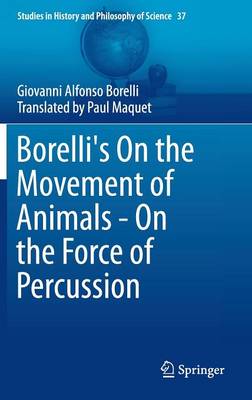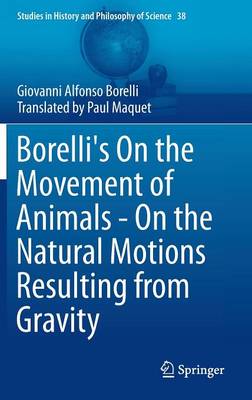Studies in History and Philosophy of Science
2 primary works
Book 37
Borelli's On the Movement of Animals - On the Force of Percussion
by Giovanni Alfonso Borelli
This volume provides an introduction to Borelli’s theory on the movement of animals and demonstrates the nature of the energy of percussion, its causes, properties and effects. Building on and moving away from the theory of mechanics as formulated by Aristotle and Galileo and countering objections expressed by Stephani degli Angeli among others, Borelli presents a completely mechanical account of the action of muscles and analyzes the way in which the center of gravity of the animal shifts in locomotion.
Originally published in Italian in 1667, then translated into Latin in 1686, the text of this volume has now been translated into English, making the text accessible to a wide readership.
This volume is the first of two volumes that contain the Introduction and physical-mathematical illustrations necessary to understand Giovanni Alfonso Borelli’s work On the Movement of Animals, the founding text of seventeenth century biomechanics. The second volume, entitled On The Natural Motions Resulting From Gravity, describes his theory and scientific experiments relating to the natural movements of bodies in a fluid environment.
Book 38
Borelli's On the Movement of Animals - On the Natural Motions Resulting from Gravity
by Giovanni Alfonso Borelli
This volume provides an introduction to Borelli’s theory on the movement of animals and describes his theory and scientific experiments relating to the natural movements of bodies in a fluid environment. It describes in great detail why and how bodies which present with different magnitudes, weights and shapes move at a greater or a smaller velocity in certain proportion in the fluid environment.
Originally published in Italian in 1667, then translated into Latin in 1686, the text of this volume has now been translated into English, making the text accessible to a wide readership.
This volume is the second of two volumes that contain the Introduction and physical-mathematical illustrations necessary to understand Giovanni Alfonso Borelli’s work On the Movement of Animals, the founding text of seventeenth century biomechanics. The first volume, entitled On the Force of Percussion, demonstrates the nature of the energy of percussion, its causes, properties and effects.

